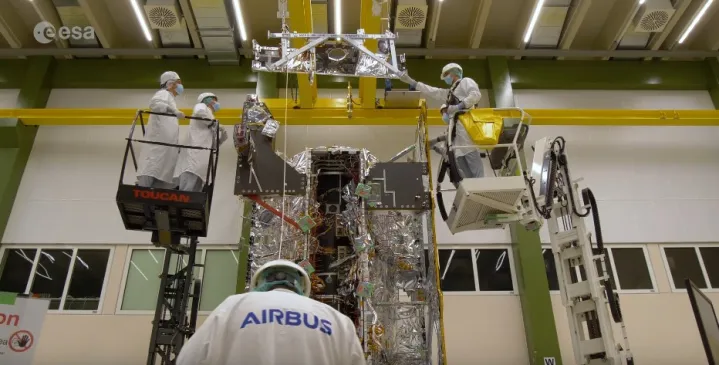The European Space Agency (ESA)’s Juice spacecraft is getting ready for its mission to Jupiter. The JUpiter ICy moons Explorer mission aims to get a close-up look at the moons of Jupiter which could potentially host life.
The spacecraft recently reached a milestone of being fully integrated. With all the spacecraft’s hardware brought together and integrated, the craft is now fully complete for the first time and ready for testing. It has been moved to an Airbus facility in Toulouse, France, for final testing before its launch in April 2023.

“This milestone is very important because here we have the spacecraft: It is integrated and ready,” explained Manuela Baroni, Juice AIT & Launcher Interface Engineer at ESA, in a video interview. “We have all the 10 instruments delivered and there, all the platform units are there, the antennas are all in place. So the spacecraft is ready for the test campaign, to verify finally that everything works as expected.”
The Juice mission will visit Jupiter as well as three of the planet’s moons: Europa, Callisto, and Ganymede. These icy moons are prime targets in the search for habitable locations in the solar system outside of Earth, as they are thought to host oceans beneath their surfaces. Juice will investigate these moons in more detail to understand their chemistry and whether they could potentially be environments that could host life.
“We have some requirements coming from the environment of Jupiter itself, like temperature and radiation,” said Cyril Cavel, Juice Project Manager, Airbus Defence & Space. “Jupiter is a very aggressive radiation environment that is making the whole design of the spacecraft even more complex.”
For the next nine months, the Juice spacecraft will be put through an extensive testing program to make sure it is ready for this environment. Then it will be shipped to French Guiana for launch from Europe’s Spaceport in Kourou on an Ariane 5 rocket. It will travel through the solar system for eight years, getting gravity assists along the way from Earth, the moon, and Venus — including a first-of-its-kind maneuver around the Earth-moon system.
It is scheduled to arrive at the Jupiter system in 2031 and to perform a four-year mission there, making flybys of the three moons and going into orbit around Ganymede before eventually impacting onto its surface.
Editors' Recommendations
- Jupiter’s icy moon Europa may be light on oxygen, lowering habitability hopes
- Saturn’s tiny moon, Mimas, hosts an unexpected ocean beneath an icy shell
- Key ingredient for life found at Saturn’s icy moon Enceladus
- Hubble captures a stunning ultraviolet image of Jupiter
- Astronauts test new moon camera for upcoming Artemis mission




